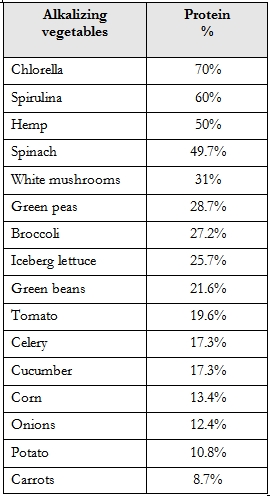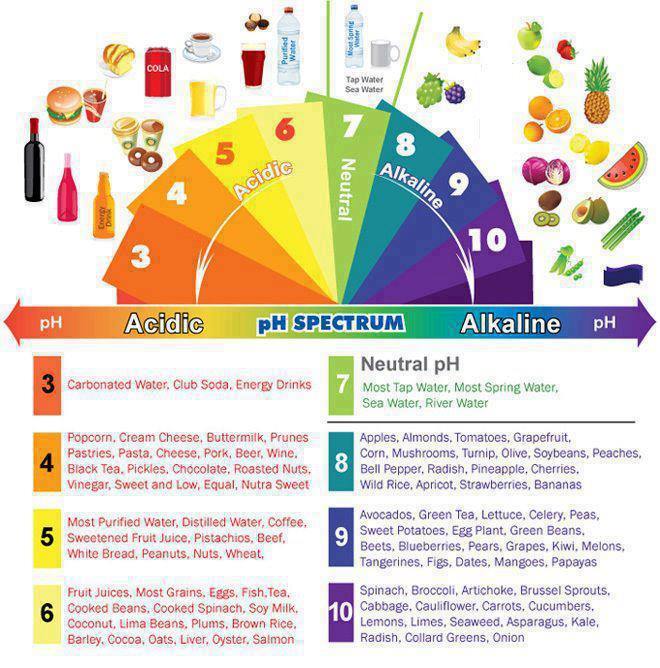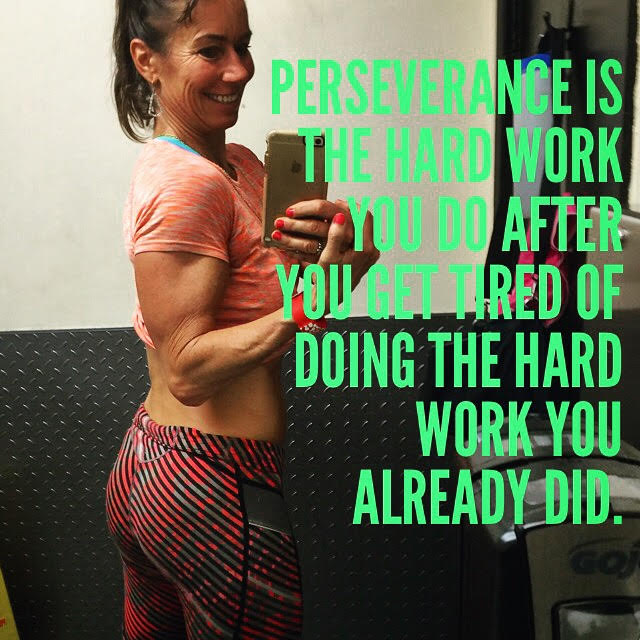An athlete with an overly acidic body will recover more slowly and consequently will experience fatigue. As with any stressor, the acidity will cause the cortisol levels to rise, which will impair sleep and make the problem worse. A sleep-deprived athlete has high cortisol levels and produces lower amounts of the growth hormone, which causes a loss of muscle mass and an increase of the fat tissue.
To correct this, the frustrated athlete starts training harder, but without a proper recovery, and the vicious circle begins. Additionally, metabolic acidosis causes kidney stones and loss of bone mass. Since it affects the body at a cellular level, it increases the production of free radicals and decreases the production of cellular energy. Many viruses and bacteria thrive in an acidic body and increase the risk for various diseases. In contrast, in an alkaline body not even cancer can develop.
Unfortunately, many athletes are used to eating processed protein bars full of preservatives and other chemicals, drinking sugary sports drinks, or consuming loads of processed protein powders in a false faith of improving performance. These “sport supplements” are highly acid-forming and in that sense, almost as bad as grabbing a soda, a candy bar, or a bag of chips.
Acid-forming nutrition is detrimental to anybody’s health, but especially to athletes. An overly acidic body negatively affects performance, prolongs recovery, decreases the intensity of training, and increases the risk of injury. Paying attention to the alkaline-acidic balance, (optimizing the body’s performance at the cellular level by maintaining an alkaline environment) will dramatically increase athletic performance.
Your body and performance depend upon the health of your cells. You need to maintain proper pH (potential hydrogen) levels to maintain good cellular health. On the pH scale, seven is neutral, any level below is acidic, and any level above is alkaline.
Chemical processes are the most efficient at an ideal pH. The body functions the best in a slightly alkaline state. Blood has a pH of 7.4 and dipping below 7.2 pH results in death. To avoid death, your body will do whatever it takes to neutralize acidic waste and maintain homeostasis, even if it means stealing the alkaline materials (calcium, magnesium, potassium, sodium, iron) from the surrounding tissues and bones. While the body has its own smart buffering system (kidneys and lungs) to neutralize the acidic waste, sometimes it is not enough.
These buffering systems are taxed and depleted by diets overabundant in meats, dairy, processed grains, sport drinks, sodas, and other processed foods, most prescription drugs, artificial sweeteners and synthetic vitamin and mineral supplements, mental stress, performance anxiety, environmental toxins, and large amounts of acidic waste from frequent high-intensity training.
When the buffer reserves are all empty, in attempt to buffer the acidic waste, the body will pull out the alkaline minerals from the bones and connective tissue, leaving them more prone to injuries such as strains, fractures, and other chronic overuse injuries.
The more energy the body spends on cleaning the acidic waste, digesting processed and overly cooked foods that lack digestive enzymes and nutrients, the less energy will be left for intense training and recovery.
The paradox of the athlete is that they eat large amounts of food and usually pay attention to their protein intake, which they believe should be high. They are used to eating commercial protein bars, powders, and shakes, which are highly acid forming, but to aid the recovery and to nourish the body, it is extremely important to consume highly alkalizing foods immediately after exercise.
The good news and solution to this paradox is that eating whole foods plants and choosing those with higher amounts of protein will deliver adequate amounts of protein, covering the athletic needs efficiently.
SPECIFIC RECOMMENDATIONS
Raw hemp protein, natural and unprocessed, contains about 50% protein (calculated per calorie, not weight) and is less acid forming than other processed proteins such as whey or soy. Hemp has high amounts of chlorophyll that is responsible for the alkaline characteristic and its green color.
Other highly alkalizing protein sources are chlorella, which contains nearly 70% protein, spirulina with over 60% protein, and green peas with about 30% of protein. A good rule for raw, whole, and unprocessed plants is that the greener they are (more chlorophyll), the more alkalizing they are. Many of the alkalizing vegetables have surprisingly high amounts of protein.

Eating many green leafy vegetables will support alkalinizing of your system even during the most intense training phases. Other good sources of alkalizing protein are sprouted lentils, beans, peas, seeds, and rice. Making a smoothie with green leafy vegetables and some hemp protein after your training session will deliver optimal nutrition for a speedy recovery.
Paying attention to the alkaline environment will not just improve your performance, but your health and wellbeing. Whole foods plant-based nutrition makes maintaining the alkaline-acidic balance much easier for the following reasons:
1. All of the animal products and dairy are acidic, and we don’t eat them anymore.
2. Most of the processed foods are acidic, which is the reason that we don’t eat them anymore.
3. All oils are acidic, but we don’t eat them anymore, or only very little.
4. Most of the vegetables and fruits are alkaline, and we eat a lot of them.
It is evident that eating a whole foods plant-based diet makes life easier from many different aspects. There are several different pH balance charts available on the internet, and they all vary slightly because of the way food pH is measured. I am not going to list the complete charts because for the plant-based whole foods athlete, things are much simpler. There are only a few acidic plants to be aware of. Make sure you are not overeating them regularly. When you do eat them, always make sure that you eat many of the alkaline plants in addition to them.

This was an excerpt from “The Athlete’s Simple Guide to a Plant-Based Lifestyle: How to easily improve your health, performance, and longevity. Works for non-athletes, too!” Find it on Amazon worldwide. Even if you don’t plan to become a plant-based athlete, you can use any of this advice to improve your health and performance. Just add more of the plants into your diet, which will naturally make you eat less of the animal products. You will be surprised how well you will feel really soon.
I have been interviewed by Dr. Pamela Peeke about the controversy of protein and how much we need to eat. As a former bodybuilder, I used to believe that tremendous amounts of protein are necessary for sport and performance. I ate 6 protein meals a day. Over the years of studying the subject on nutrition and performance, I have changed my view quite radically. Listen to this 8-minute interview.
If you already own any of my books and enjoy reading them, please, write a little review on Amazon to help other readers to find my work. Feel free to email me any time if you have questions about anything.



